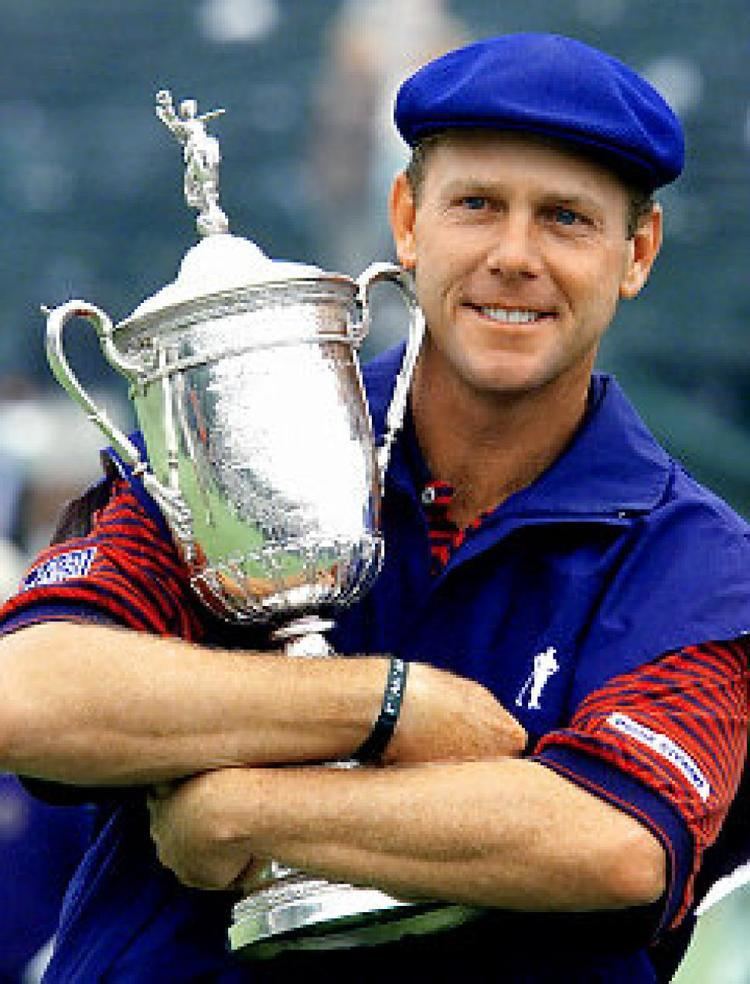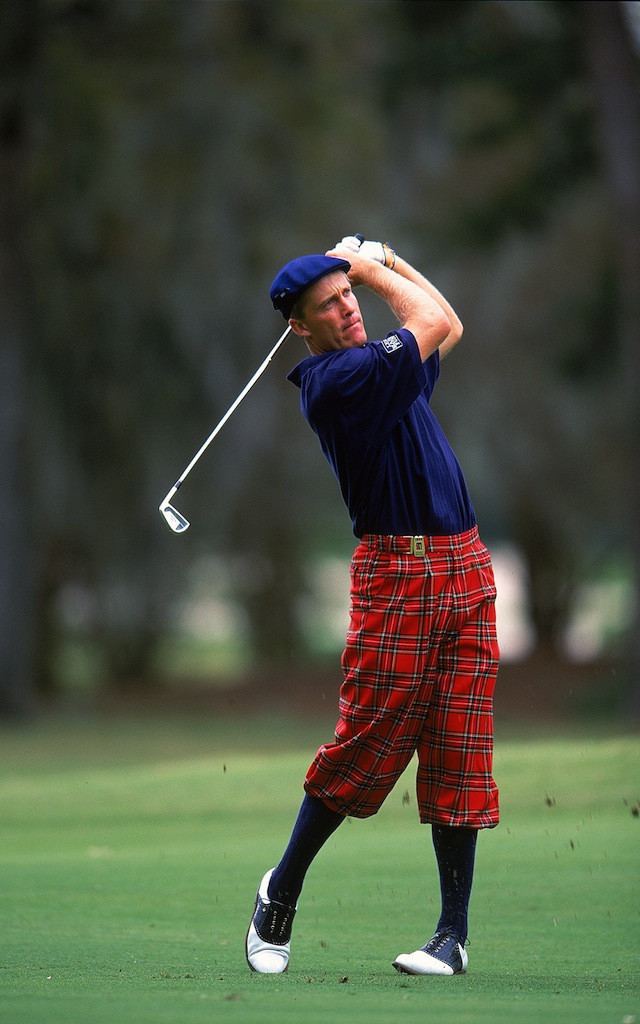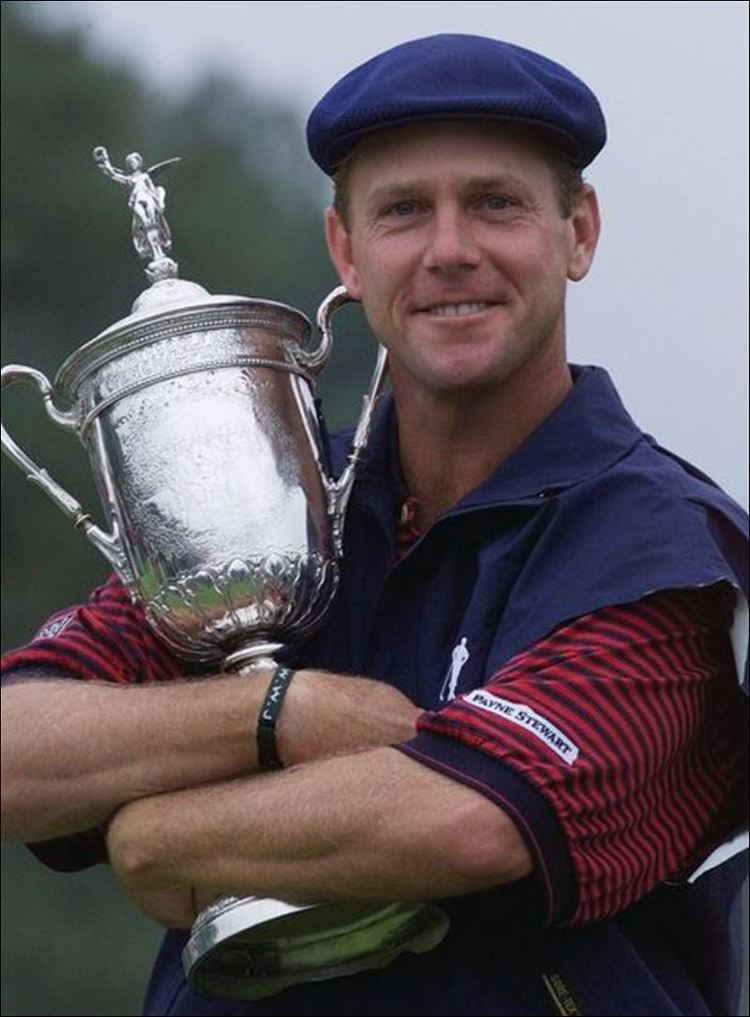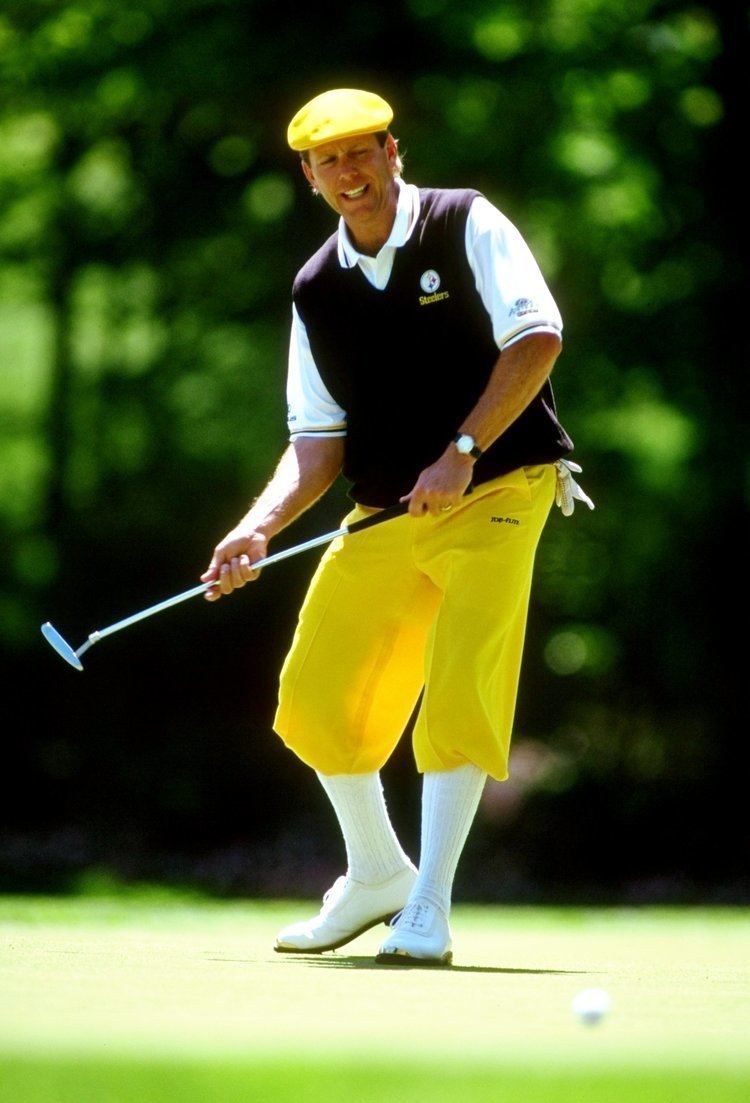Full name William Payne Stewart Professional wins 25 Nationality United States Name Payne Stewart | Turned professional 1979 Role Professional golfer Height 1.85 m | |
 | ||
Born January 30, 1957Springfield, Missouri ( 1957-01-30 ) College Southern Methodist University, 1979 Spouse Tracey Stewart (m. 1981–1999) Siblings Susan Stewart Daniel, Lora Stewart Thomas People also search for Tracey Stewart, Bee Payne-Stewart, Bill Stewart, Ken Abraham, Bo Rein Children Chelsea Stewart, Aaron Stewart | ||
Former tour(s) PGA TourAsian Tour | ||
A Tribute to Payne Stewart as a Golf Instructor
The 1999 U.S. Open at Pinehurst
William Payne Stewart (January 30, 1957 – October 25, 1999) was an American professional golfer who won eleven PGA Tour events, including three major championships in his career, the last of which occurred a few months before he died in an airplane accident at the age of 42.
Contents
- A Tribute to Payne Stewart as a Golf Instructor
- The 1999 US Open at Pinehurst
- Early years
- Early professional career 19811988
- Major victories 19891999
- Death
- Legacy
- PGA Tour wins 11
- Japan Golf Tour wins 1
- Other wins 11
- Wins 3
- Results timeline
- Summary
- US national team appearances
- References

Stewart gained his first major title at the 1989 PGA Championship. He won the 1991 U.S. Open after a playoff against Scott Simpson. At the 1999 U.S. Open Stewart captured his third major title after holing a 15-foot (5 m) par putt on the final hole for a one stroke victory.

Stewart was a popular golfer with spectators, who responded enthusiastically to his distinctive clothing. He was reputed to have the biggest wardrobe of all professional golfers and was a favorite of photographers because of his flamboyant attire of ivy caps and patterned pants, which were a cross between plus fours and knickerbockers, a throwback to the once-commonplace golf "uniform". Stewart was also admired for having one of the most gracefully fluid and stylish golf swings of the modern era.

Early years

Stewart was born and raised in Springfield, Missouri, and attended Greenwood Laboratory School, a K-12 school, on the campus of Missouri State University. He played collegiate golf at Southern Methodist University in Dallas, Texas, where he was a member of Phi Gamma Delta and graduated in 1979. Payne Stewart and Tracy Ferguson met each other in Kuala Lumpur in 1980 while he was playing on the Asian tour.
Early professional career: 1981–1988

Stewart failed to earn a PGA Tour card at Qualifying School in his graduation year, so he played on the Asian Tour for a couple of years, winning two tournaments in 1981. Later that year, he earned his PGA Tour card for 1982 and won his first title on the tour at that year's Quad Cities Open. This win was especially memorable to him because it was the only time his father, Bill, saw him win. Stewart's father had played in the 1955 U.S. Open, and had introduced his son to the game.
In 1983, Stewart gained his second PGA Tour victory by winning the Walt Disney World Golf Classic by two strokes. At the 1985 Byron Nelson Golf Classic, Stewart came to the 72nd hole with a three-shot lead. Moments after Bob Eastwood birdied the final hole of regulation, Stewart took a double bogey to end the tournament tied for first. Stewart then made another double bogey on the first playoff hole, causing him to lose to Eastwood. Stewart's 1985 Byron Nelson Classic finish has been called one of the all-time golf blunders.
In 1985, Stewart came close to winning The Open Championship, when he finished one stroke behind the champion Sandy Lyle.
Stewart briefly led the U.S. Open in 1986 during the back-nine of the final round at Shinnecock Hills. After birdieing the 11th and 12th, Stewart took a one-shot lead, but he then had bogeys at the 13th and 14th, finishing the tournament tied for sixth place, behind the winner Raymond Floyd.
Stewart had four runner-up finishes on the PGA Tour in 1986. Despite not winning a tournament that year, he had the most top-10 finishes of any player on the PGA Tour in 1986, finishing inside the top-10 sixteen times.
Stewart won the Hertz Bay Hill Classic in Orlando, Florida in 1987, shooting a third round of 63 and a final round of 65 to beat South African David Frost by three shots. The tournament was a two-man duel in the final round, as Frost finished eight shots ahead of the third-place finisher Dan Pohl. Stewart's victory was a memorable one to him as it came on his home course. His house was situated adjacent to the 12th tee of the Bay Hill Club course in Orlando, Florida. Stewart's cumulative tournament score of 264 is, to date, still a record for the lowest aggregate score over 72 holes in the event, which later became known as the "Arnold Palmer Invitational" held at the same Bay Hill venue.
After his 1987 victory at Bay Hill, Stewart donated his $108,000 prize money to a Florida hospital in memory of his father, who died of cancer in 1985.
Stewart had two runner-up finishes on the PGA Tour in 1988, at The Honda Classic and the Provident Classic.
Major victories: 1989–1999
In April 1989, Stewart won the MCI Heritage Golf Classic by five strokes, with a then tournament-record score of 268, 16-under-par. His victory at the Heritage Classic was his 18th top-10 finish on the PGA Tour since his previous win at the Bay Hill Classic in March 1987. Stewart was gaining a reputation for being one of the most consistent players on the PGA Tour and one of the best players in the world not yet to have won a major championship at that point.
At Kemper Lakes Golf Club, Stewart won the PGA Championship in 1989, his first major title. At the start of the final round, Stewart was six shots behind the leader Mike Reid. He made up five strokes in the final three holes to overtake Reid and win by a stroke. Stewart's back-nine of 31 included birdies on four of his last five holes. He was able to gain the lead over Reid, who bogeyed the 16th, double-bogeyed the 17th, and missed a seven-foot (2 m) birdie putt on the 18th, which would have forced a playoff. After the tournament, Stewart said: "This is a dream I've been trying to realize for a long time." Reid shed tears and said: "As disappointed as I am, I'm happy for Payne."
The following year, Stewart became the first player to win back-to-back titles at the MCI Heritage Golf Classic at Harbour Town Golf Links, winning a playoff against Larry Mize and Steve Jones on the second extra hole with an 18-foot (5 m) birdie putt. This was his first playoff win on the PGA Tour, having lost all five of his playoffs in the 1980s. In May 1990, Stewart won his second tournament of the year at the GTE Byron Nelson Golf Classic. At the end of 1990, Stewart was ranked as the fifth-best golfer in the world on the Official World Golf Ranking.
Stewart's second major title came at the 1991 U.S. Open after an 18-hole Monday playoff with Scott Simpson on a windblown Hazeltine National Golf Club course in Minnesota. Stewart was two shots behind Simpson going into the final three holes of the playoff. After the 16th hole, the match was squared, as Stewart holed a 20-foot (6 m) birdie putt and Simpson missed a 3-foot (1 m) par putt. Stewart's par on the 18th hole won the playoff by two strokes.
The following month, Stewart won the 1991 Heineken Dutch Open by nine shots, which included a course record of 62 in the third round. Stewart won the Hassan II Golf Trophy in Morocco in 1992 and 1993.
In 1993 at Royal St George's Golf Club in England, Stewart's fourth round of 63 tied the record for the lowest individual round in The Open Championship. He was one of 10 players, until Branden Grace shot a 62 in 2017, to hold the record for shooting a 63 at the British Open. In 1995, Stewart gained his first U.S. PGA Tour win in four years by winning the Shell Houston Open in a playoff over Scott Hoch, who lost a six-shot lead with seven holes to play. Hoch collapsed on the back-nine with three bogeys and a double-bogey on the 17th when his tee shot found water. Stewart won the playoff on the first extra hole.
In the 1998 U.S. Open at Olympic Club in San Francisco, Stewart had a four-shot lead going into the final round, but lost to Lee Janzen by a stroke. Stewart missed a 25-foot birdie putt on the 18th hole of his final round, which would have forced a playoff with Janzen.
The following year at the 1999 U.S. Open at Pinehurst Resort, Stewart won his last major title, memorably holing a 15-foot par putt that defeated Phil Mickelson by a stroke in the final round when Tiger Woods and Vijay Singh were also in contention for the trophy. Stewart credited his winning putt to being more at peace with himself after his strengthened religious belief. A statue of Stewart celebrates his winning putt behind the 18th green of the No. 2 course at Pinehurst Resort.
At the time of his death, Stewart was ranked third on the all-time money list and in the top 10 of the Official World Golf Ranking — he had been ranked in the top 10 for almost 250 weeks from 1986 to 1993, and again in 1999. At a time of international domination of the golf scene in the late 1980s and early 1990s, he was often the highest-ranked American player.
Stewart represented the United States on five Ryder Cup teams (1987, 1989, 1991, 1993, and 1999). He also played for the U.S. on three World Cup teams.
Stewart was known for his patriotic passion for the Ryder Cup, once saying of his European opponents, "On paper, they should be caddying for us." The United States team was 3–1–1 during the five times he played. He was disappointed to miss out in 1995 and 1997, when he failed to qualify automatically and was not chosen as a captain's pick. In the 1999 Ryder Cup, Stewart criticized the heckling of European player Colin Montgomerie. With victory assured for the United States, Stewart conceded a putt (and his own singles match) to Montgomerie on the 18th hole. "This game is about sportsmanship," Stewart said afterwards.
Stewart was a golfing traditionalist, who once said: "In the United States, all we do is play the ball in the air." He gained an affection for links golf, becoming a popular figure in Ireland after playing on Irish courses to warm up for The Open Championship. After he died in 1999, Waterville Golf Links in County Kerry, Ireland, commissioned a bronze statue of Stewart to pay tribute to him and his affiliation with Waterville.
For a large part of his career, Stewart was known for his National Football League (NFL) sponsorship, whereby he wore the team colors of the geographically closest NFL franchise; the sponsorship ended in May 1995.
Stewart appeared on an episode of the American television sitcom Home Improvement titled "Futile Attraction", which aired on March 10, 1998, and featured Stewart as himself.
Stewart was also a musician, and played harmonica in the blues rock group Jake Trout and the Flounders, which also included fellow golfers Larry Rinker and Peter Jacobsen. The band released one album, I Love to Play in 1998. The music video for the title track, a golf-themed parody of Randy Newman's "I Love L.A.", earned rotation on VH-1.
Death
On October 25, 1999, a month after the American team rallied to win the Ryder Cup and four months after his U.S. Open victory, Stewart was killed in the depressurization of a Learjet. He was flying from his home in Orlando, Florida, to Texas for the year-ending tournament, The Tour Championship, held at Champions Golf Club in Houston. Traveling on a Monday morning, Stewart was planning to stop off in Dallas to discuss building a new home course for the SMU golf program with Dallas-based real estate developer Jeff Blackard. The last communication received from the pilots was at 9:27 am EDT, and the aircraft made a right turn at 9:30 am EDT that was probably the result of human input.
At 9:33 am, the pilots did not respond to a call to change radio frequencies, and no further contact from the aircraft was received. The aircraft was apparently still on autopilot and angled off-course, as observed by several U.S. Air Force (and Air National Guard) F-16 fighter aircraft as it continued its flight over the Southern and Midwestern United States. The military pilots observed frost or condensation on the windshield (consistent with loss of cabin pressure) which obscured the cockpit, and no motion was visible through the small patch of windshield that was clear.
National Transportation Safety Board (NTSB) investigators later concluded that the aircraft suffered a loss of cabin pressure and that all on board were incapacitated due to hypoxia as the aircraft passed to the west of Gainesville, Florida. A delay of only a few seconds in donning oxygen masks, coupled with cognitive and motor skill impairment, could have been enough to result in the pilots' incapacitation. The NTSB report showed that the aircraft had several instances of maintenance work related to cabin pressure in the months leading up to the accident. The NTSB was unable to determine whether they stemmed from a common problem. Replacements and repairs were documented, but not the pilot discrepancy reports that prompted them, or the frequency of such reports. The report gently chides Sunjet Aviation for the possibility that this would have made the problem harder to identify, track, and resolve, and the fact that in at least one instance, the aircraft was flown with an unauthorized maintenance deferral for cabin pressure problems.
According to a U.S. Air Force timeline, a series of military aircraft provided an emergency escort to the stricken Lear, beginning with an F-16 from Eglin Air Force Base, about an hour and 20 minutes (9:33 EDT to 9:52 CDT – see NTSB report on the crash) after ground controllers lost contact. The aircraft continued flying on autopilot until it ran out of fuel and crashed into a field near Mina, South Dakota, a town 10 miles (16 km) west of Aberdeen, after an uncontrolled descent. The five other people aboard the aircraft included Stewart's agents Robert Fraley and Van Ardan, pilots Michael Kling and Stephanie Bellegarrigue, and Bruce Borland, a highly regarded golf-course architect with the Jack Nicklaus design company.
At the time of his death, Stewart had won $12,673,193 in career earnings. He won over $2 million during the 1999 season, and finished seventh on the year's money list.
Legacy
At that week's tournament, The Tour Championship, Stewart's good friend, Stuart Appleby, organized a tribute to his friend. With Stewart's wife's permission, he wore one of Payne's own signature outfits for the final round of the tournament on Sunday, and most of the rest of the golfers in the field wore "short pants" that day, as well.
One year after Stewart's death, his widow Tracey and their two children, and the family of Stewart's agent, Robert Fraley, who also died on that flight, brought a lawsuit against Learjet, flight operator SunJet Aviation, Inc., and aircraft owner JetShares One Inc. They alleged that a cracked adapter resulted in an airflow valve detaching from the frame, causing a fatal loss of cabin pressure. They also claimed that the aircraft was severely out of maintenance due to negligence by SunJet. In April 2000 as part of a federal criminal investigation, the Federal Bureau of Investigation raided SunJet and seized its flight logbooks, effectively grounding all of its aircraft. The investigation was dropped in 2002, but it was too late to save SunJet; unable to legally operate, it had filed for bankruptcy protection in June 2000. The case against Learjet went forward in state court in Orlando. In June 2005, jurors found that the aircraft's manufacturer had no liability in the deaths of Stewart and Fraley and that no negligence was found in the design or manufacture of the aircraft.
The segment of Interstate 44 passing through Springfield, Missouri, was designated the "Payne Stewart Memorial Highway" in his memory. He has a street in Fullerton, California, and a "Payne Stewart Drive" in Surrey, British Columbia, Canada, leading into Northview golf course designed by Arnold Palmer, named after him. Finally, Payne Stewart Drive in Jacksonville, Florida, houses The First Tee along with a Job Corps center.
The communities of Mina and Aberdeen created their own memorial. Jon Hoffman, owner of the property where the aircraft crashed, contacted Stewart's widow and several family members of other crash victims. All agreed that the memorial would be a rock pulled from the crash site, engraved with the victims' names and a Bible passage. Hoffman fenced in about an acre (4,000 m²) of the property surrounding the memorial.
In 2000, the PGA Tour established the Payne Stewart Award, given each year to a player who shows respect for the traditions of the game, commitment to uphold the game's heritage of charitable support, and professional and meticulous presentation of himself and the sport through his dress and conduct. A bronze statue of Stewart celebrating his winning putt in 1999 at Pinehurst overlooks the 18th green of the No. 2 course.
In tribute to Stewart, as well as his southwestern Missouri roots, the Payne Stewart Golf Club was opened in Branson, Missouri, in June 2009 with the approval of Stewart's widow. Ground-breaking on the $31 million layout took place on July 24, 2006. The 7,319-yard, 18-hole course was designed by Bobby Clampett and Chuck Smith. Each hole on the course is named for some aspect or notable moment in Stewart's life. The fifth hole, for example named "Road Hole", recounts the incredible par Stewart made in the first round of the 1990 Open Championship at Old Course at St Andrews when he was forced to knock his third shot against the wall behind the green at the Old Course's treacherous 17th. His ball finished just on the back fringe from where he chipped in.
On the 10th anniversary of Stewart's death in 2009, Golf Channel presented a special program to remember the life of the late golfer. It included recorded interviews with family and friends, and archived videos of his golf career.
On the first day of the 2014 U.S. Open, Rickie Fowler wore plus fours and argyle socks in tribute to Stewart. The championship was at the Pinehurst Resort where Stewart won his last major championship only a few months before his death.
PGA Tour wins (11)
^ Tournament reduced to 54 holes due to inclement weather.
PGA Tour playoff record (3–6)
Japan Golf Tour wins (1)
Other wins (11)
Wins (3)
1Defeated Simpson in an 18-hole playoff – Stewart 75 (+3), Simpson 77 (+5).
Results timeline
CUT = missed the half-way cut
"T" = tied
Summary
U.S. national team appearances
Professional
